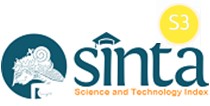Asimilasi sebagai Terjemahan Bentuk Adaptasi dalam Resiliensi Komunitas Kampung Kota di Kampung Sudiroprajan Surakarta
Abstract
Resilience is a concept that integrates between mitigation, adaptation and innovation. On a smaller scale, community-based resilience forms a translation of strong social capital. In Indonesia the majority of the urban community is formed in a container called Kampung Kota. Kampung Kota has the character of tolerance, cohesiveness, and solidarity. Kampung Kota becomes important to be used as research setting because with its characteristic, Kampung Kota able to produce its own value so that it can face threat, pressure and turmoil with its way. Kampung Sudiroprajan is one of the kampung Kota in Surakarta City that has unique resilience experience especially related to the relationship between Javanese and Chinese. This study aims to determine the concept of resilience that is formed in Kampung Sudiroprajan as part of the Kampung Kota community. Kampung Sudiroprajan can give an idea of resilience concept of community scale which tend to original and typical. This research uses case study methodology by exploring the form of resilience conducted in Kampung Sudiroprajan. This study found the uniqueness of adaptation process of Kampung Sudiroprajan community. Adaptation is translated in the form of assimilation. The assimilation resulted in the social condition of the society which tends to be more fluid, especially in the face of several times the events that become threats, pressure, and turmoil for the Chinese. Assimilation creates a new value that becomes the glue of the relationship for the Javanese Ethnic community and the Chinese Ethnic Community.
Keywords
Full Text:
PDFReferences
Adger, W. N. 2000. "Social and ecological resilience : are they related ?", 3, 347–364.
Budiati, Atik Catur.2010. “Ketahanan Masyarakat Kota Solo (Model Pengelolaan Konflik Tionghoa – Jawa melalui Pendekatan Ketahanan Masyarakat)” Jurnal Sosiologi Dilema.25, 70- 78
Budiharjo, Eko.2009. Perumahan Permukiman di Indonesia. Bandung: Alumni
Brown, A., Dayal, A., & Rumbaitis Del Rio, C. 2012. "From practice to theory: emerging lessons from Asia for building urban climate change resilience". Environment and Urbanization, 24(2), 531–556.
Davoudi, S., Shaw, K., Haider, L. J., Quinlan, A. E., Peterson, D., Wilkinson, C., … Quinlan, A. E. 2012. "Resilience : A Bridging Concept or a Dead End ? “ Reframing ” Resilience : Challenges for Planning Theory and Practice Interacting Traps : Resilience Assessment of a Pasture Management System in Northern Afghanistan Urban Resilience : What Does it Mean in Planning Practice ? Resilience as a Useful Concept for Climate Change Adaptation ? The Politics of Resilience for Planning : A Cautionary Note, 9357(May), 299–333.
Godschalk, D. R. 2003. "Urban Hazard Mitigation: Creating Resilient Cities". Natural Hazards Review, 4(3), 136–143. https://doi.org/10.1061/(ASCE)1527-6988(2003)4:3(136) diakses 4/3/17
IFRC. 2012. Characteristics of a Safe and Resilient Community Community Based Disaster Risk Reduction Study. ARUP International Development, (September), 184. https://doi.org/1224200 E diakses 7/4/17
Indrayanti, Elyas R. 2009. Perekonomian Etnis Tionghoa di Surakarta tahun 1959-1974. Skripsi program studi sejarah Universitas Sebelas Maret Surakarta.
Lang, T. 2012. "How do cities and regions adapt to socio-economic crisis? Towards an institutionalist approach to urban and regional resilience". Raumforschung Und Raumordnung, 70(4), 285–291. https://doi.org/10.1007/s13147-012-0170-2 diakses 7/4/2017
Matyas, D., Regional, S., Adviser, R., Pelling, M., & Kingdom, U. 2015. "Positioning resilience for 2015 : the role of resistance , incremental adjustment and transformation in disaster risk management policy", 39, 1–18.
Perwanto, Hari. 1999. "Asimilasi, Akulturasi, dan Integrasi nasional". Humaniora.12. 29-37
Roychansyah, Muhammad S.2012.Kota Tangguh: Definisi, Konsep, Konteks. UGM. Yogyakarta
Setiawan, Bakti. 2010. Kampung Kota Dan Kota Kampung-Potret Tujuh Kampung di Kota Jogja. Yogyakarta: Pusat Studi Lingkungan Hidup UGM
Simmie, J., & Martin, R. 2010. "The economic resilience of regions : towards an evolutionary approach", (January), 27–43.https://doi.org/10.1093/cjres/rsp029 diakses 14/3/2017
Sugiyono. 2011. Metode Penelitian Kuantitatif Kualitatif dan R&D. Bandung: Alphabeta
Wilkinson, C. 2011. "Social-ecological resilience : Insights and issues for planning theory".
Widyaningsih, Eka Deasy.2007. Masyarakat “china balong” Sudiroprajan (Studi Interaksi Sosial Masyarakat China-Jawa Di Surakarta Pada Pertengahan-Akhir Abad XX).Skripsi program studi sejarah Universitas Sebelas Maret Surakarta.
Yin, Robert K. 2002. Studi Kasus (Desain dan Metode). Jakarta: Raja Grafindo Persada.
Žilėnienė, B. P. 2014. "Integrated Approach to a Resilient City : Associating Social , Environmental and Infrastructure Resilience in its Whole", 1–14.
Refbacks
- There are currently no refbacks.


.png)

.jpg)









